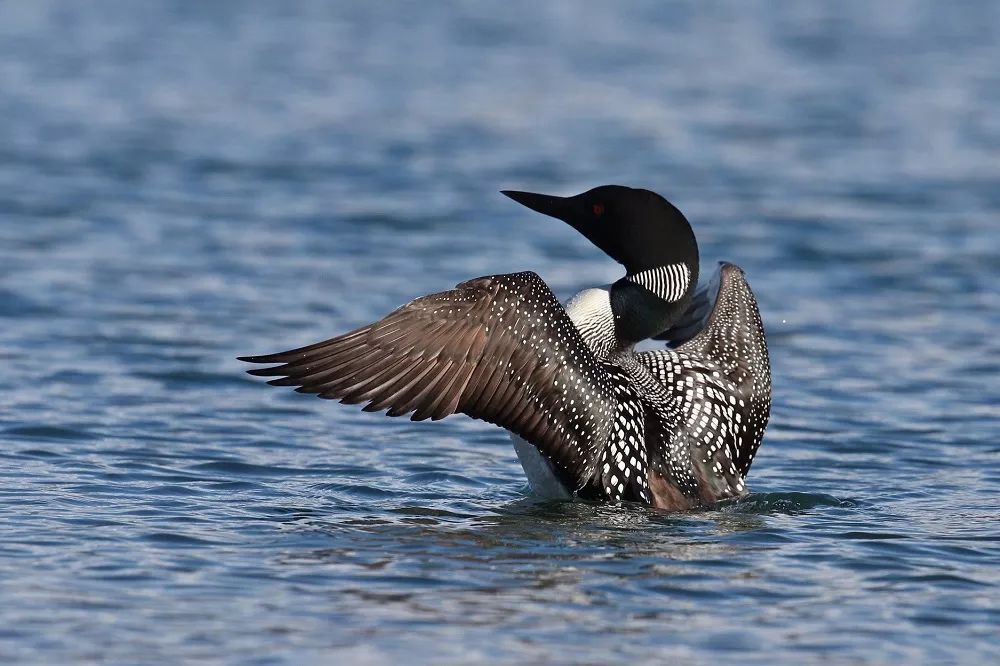The Common Loon (Gavia immer), a striking bird species found in North America, is renowned for its captivating appearance and haunting calls that echo across lakes and waterways. In this article, we delve into the remarkable physical characteristics of the Common Loon, exploring its distinctive plumage, unique adaptations, and overall appearance that make it an iconic symbol of North America’s wild landscapes.
Plumage and Size
The Common Loon boasts an impressive and unmistakable appearance. Adult Common Loons measure approximately 28 to 36 inches (71 to 91 cm) in length, with a wingspan of 47 to 63 inches (119 to 160 cm). They weigh between 6.5 to 12 pounds (2.9 to 5.4 kg), with males being slightly larger than females. The loon’s body is streamlined, ideal for swift underwater movement during diving.
Adults display a striking contrast of black and white plumage, with a glossy black head, neck, and upper body, while the underparts, including the throat and belly, are gleaming white. The distinct pattern continues on its back, where the black extends in a checkerboard-like design, creating a striking visual effect when viewed from a distance. In breeding season, the adult’s head acquires a rich iridescent sheen, showcasing hues of green and purple that add to its allure.
Unique Adaptations
The Common Loon possesses specialized adaptations that contribute to its aquatic lifestyle and extraordinary hunting abilities:
Beak: The Common Loon’s beak is long and pointed, perfect for catching fish. It is also slightly curved, which allows the bird to grasp its prey firmly and swallow it whole. The beak has a dark coloration that matches the bird’s overall appearance, making it difficult for fish to spot as the loon approaches.
Eyes: One of the most striking features of the Common Loon is its bright red eyes. These vibrant eyes are surrounded by a small patch of white feathers that adds to the bird’s overall striking appearance. The eyes are located far back on the bird’s head, which helps to improve its underwater vision while hunting for fish.
Webbed Feet: The Common Loons have sturdy webbed feet positioned far back on their bodies, which are ideal for propulsion through water. While excelling in aquatic environments, this positioning makes them less agile on land, often requiring a running start to take off.
Diving Abilities: The Common Loon is an exceptional diver, capable of descending to impressive depths in search of prey. Its dense bones provide buoyancy, while its streamlined body and powerful wings propel it underwater. The loon’s ability to close its nostrils and flatten its feathers helps minimize resistance and increase maneuverability while submerged.
Voice and Calls
Beyond its striking appearance, the Common Loon is renowned for its haunting vocalizations, which vary between low, eerie wails, yodel-like cries, and soft chuckles. These calls serve various purposes, including territorial defense, communication between mates, and contact between parents and offspring. The loon’s distinct calls add an auditory dimension to its already captivating presence in its natural habitat.
Habitat
Common Loons are found in freshwater lakes and ponds throughout much of North America, from Alaska to the northeastern United States. During the winter months, they migrate to coastal waters and estuaries, where they can be seen diving for fish in shallow waters.
Beaviorh
Common Loons are excellent swimmers and divers. They use their powerful legs and wings to propel themselves underwater, where they can remain for several minutes in search of fish. They are also capable of flying long distances at high speeds, with some birds reported to have reached speeds of over 80 mph (130 km/h) during migration.
Conservation Status
The Common Loon is listed as a species of least concern by the International Union for Conservation of Nature (IUCN), although some populations have declined due to habitat loss and environmental pollution. Efforts to protect the Common Loon have included the establishment of protected areas, the regulation of hunting and fishing, and public education campaigns.
Conclusion
The Common Loon is a remarkable bird species that is well-known for its unique appearance, haunting call, and impressive diving abilities. Its distinctive black-and-white plumage and haunting call make it a popular subject for nature lovers and photographers. While the species is not currently endangered, it is important to continue efforts to protect its habitat and ensure that it continues to thrive in the wild.
Related topics:
- Canada’s National Bird: The Common Loon
- Do Common Loons Migrate? [Revealed!]
- What Do Common Loons Eat?


 Facebook
Facebook  Instagram
Instagram  Youtube
Youtube 